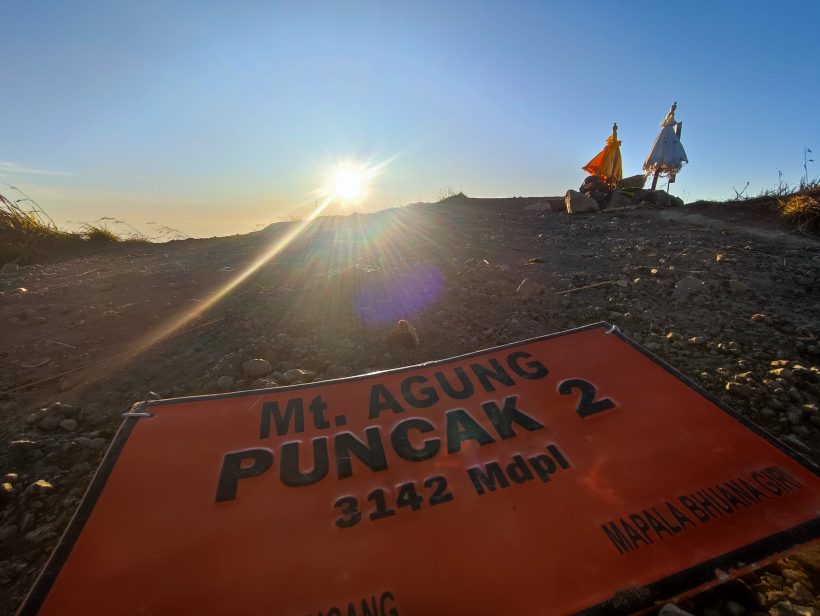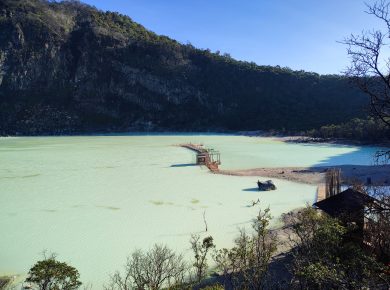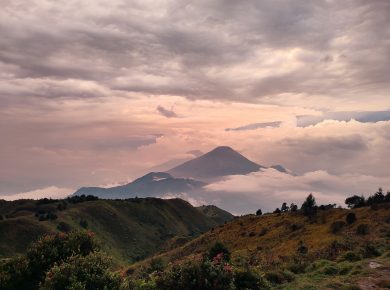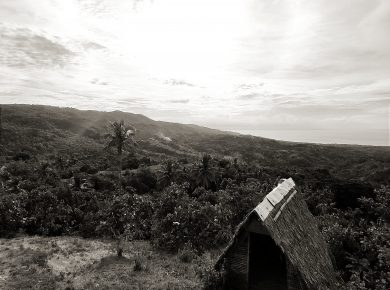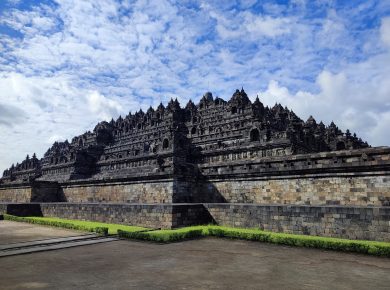Mount Agung is an active volcano in Bali’s Karangasem Regency, reaching a height of 3,031 meters (9,944 feet). Balinese Hindus consider it to be a sacred mountain since it is Bali’s highest point. As well as offering incredible views of Bali’s coastline and island, Mount Agung is also one of Bali’s most popular hiking destinations.
Climbing this mountain is challenging. The weather is unpredictable, and the trail is steep and rocky. But we’ve covered all the essentials and will tell you everything you need to know about hiking Gunung Agung.
Contents
Gunung Agung Eruption Facts
Some crucial facts:
- In Indonesia’s history, the 1963-1964 eruption was one of the largest and most destructive. A total of 1,600 people were killed and 86,000 were left homeless as a result.
- Infrastructure and agriculture in Bali were both severely damaged by the eruption.
- Gunung Agung has been acting more actively in recent years. The volcano started spewing smoke and ash in 2017, and in 2018, it started spewing lava.
- Ashes rose up to 9 kilometers (5.6 miles) into the air when Gunung Agung erupted once more in 2019.
- Even now, the volcano is still active, and another eruption is always a possibility.


When to Go
It is recommended to climb Mount Agung between April and October, which is the dry season. The trails can become treacherous and slick during the rainy season. Considering that the volcano is active and there is always a chance of an eruption, it is also crucial to check its activity level before climbing.
How to Get There
Approximately 45 kilometers from the town of Ubud, Mount Agung is situated in the eastern region of Bali. Hiring a private driver or using a tour bus to get to the trailhead is the most practical option.
Which Route to Take
There are two primary ways to reach Mount Agung’s summit:
- The route through Besakih is longer and more difficult, but it also has the most picturesque scenery. The Besakih Temple Complex, Bali’s biggest and most significant Hindu temple, serves as the trailhead.
- Although the Pasar Agung route is shorter and simpler, it is also less attractive. The Pasar Agung Temple is where the trail begins.
The trail’s map

Source: gunungbagging.com
How Long Does It Take to Climb Mount Agung?
Depending on your level of fitness and the trail you choose, Mt. Agung can take anywhere from one to four hours to climb. The amount of time required for ascent and descent on the Besakih trail is approximately 5–7 hours. The ascent and descent of the Pasar Agung trail each take about 4–5 hours.
Mount Agung Trekking Price
Depending on the organization or company you select and the location from which you begin your trek, there are different price ranges for climbing Mount Agung. Trekking up Mount Agung via the Besakih Temple costs between $85 and $110 USD per person, whereas trekking up Mount Agung via the Pasar Agung Temple costs between $80 and $100 USD per person for groups of at least two.
You can check out Bali Trekking Tour’s Mount Agung Sunrise Trekking Tour if you are interested in making a reservation. This tour includes private transportation, a trekking guide, a walking stick and headlamp, coffee and/or tea, breakfast, bottled water, and entry to Mount Agung. The adult-only tour lasts 8 to 10 hours and costs $109 USD per person.

What to Bring
The following items are essential to bring if you intend to climb Mount Agung:
- Reliable hiking boots
- A sweater or jacket
- Attire for the rain
- 2 liters or more of water per person minimum
- Foods or snacks
- Both a flashlight and a headlamp
- First-aid supplies

Mount Agung Hike Difficulty—Safety Tips
It is important to be aware of the dangers associated with climbing Mount Agung because it is an active volcano. There is always a chance that the volcano will erupt again; the most recent one was in 2017.
The Indonesian Volcanology and Geological Disaster Mitigation Center (PVMBG) should be consulted before embarking on a Mount Agung hike to determine the volcano’s condition. Ashes falling to the ground, sulfurous gas emissions, and ground tremors are some additional indications of volcanic activity that you should be aware of.
You must leave the mountain right away if you experience any of the warning signs or symptoms of volcanic activity.
Hints in theses:
- Never climb a volcano without first checking its status.
- Starting your hike early in the day will give you plenty of time to return before dusk.
- Food and drink should be brought in plenty.
- Bring reliable hiking boots and loose-fitting clothing.
- Keep in mind your altitude and take breaks as necessary.
- Do not climb alone.

Mount Agung Hike Reviews
In Bali, Indonesia, Mount Agung is a well-liked hiking destination, but before climbing the mountain, it is important to be aware of the difficulties and dangers involved. The following are opinions shared by seasoned hikers:
- “An amazing and challenging hike with stunning views. The sunrise from the summit is unforgettable.”
- “Our guide was excellent and made the hike much easier and more enjoyable.”
- “A must-do for any experienced hiker visiting Bali.”
- “The hike is very challenging and steep. It is important to be in good physical condition before attempting it.”
- “There is always the risk of an eruption, so it is important to check the status of the volcano before climbing.”
- “Some of the trails are poorly marked and can be dangerous.”

Places to stay around Mount Agung
Here are some options:
- Matahari Tulamben Resort, Dive & SPA: This resort is situated in Tulamben, Bali, and provides a number of amenities including a spa, pool, and restaurant. About 7.8 miles separate it from Mount Agung.
- The Liberty Dive Resort is a hotel with a pool, a restaurant, and a bar that is situated in Tulamben, Bali. About 7.6 miles separate it from Mount Agung.
- The Tauch Terminal Resort Tulamben is a resort with a pool, a restaurant, and a bar that is situated in Tulamben, Bali. The distance to Mount Agung is about 7.6 miles.
- La Bila Dive Resort: This Bali resort, which is situated in Karangasem, provides a number of amenities like a restaurant and a pool. The distance to Mount Agung is about 9.7 miles.
Other things to do around
There are several additional activities in the vicinity of Mount Agung if you have the time, such as:
- Taking a trip to the Besakih Temple complex
- Going to the Pasar Agung Temple
- Going to the Tirta Empul Temple, which has a holy spring where you can take a bath
- Visiting the Lempuyang Temple, known for its “Gates of Heaven”
- Visiting the Tenganan Village, a traditional Balinese village
- Hiking to the top of Mount Batur, another active volcano in Bali

FAQ on Gunung Agung Trekking
Is trekking on Mount Agung permitted?
Yes, Mount Agung is accessible for trekking, but it is important to understand the dangers. Even though eruptions are uncommon, the volcano is still active and could still happen. Additionally, it is critical to be ready for the difficult trek, which has narrow, rocky, and steep trails.
Which route is best for trekking Mount Agung?
The Besakih Temple route and the Pasar Agung Temple route are the two principal hiking paths on Mount Agung. The more well-known and thought to be simpler of the two is the Besakih Temple route. Although the Pasar Agung Temple route is shorter and more difficult, it provides superior scenery.
How much time does the Mount Agung trek take?
Depending on your level of fitness and the route you take, climbing Mount Agung requires a different amount of time. The ascent and descent of the Besakih Temple route take about 5–7 hours each. The ascent and descent of the Pasar Agung Temple route take about 3–4 hours each.
What is the best time of year to trek Mount Agung?
The best time of year to trek Mount Agung is during the dry season, which runs from May to October. During the rainy season (November to April), the trails can be slippery and dangerous.
What do I need to bring for trekking Mount Agung?
Here are some essential items to bring for trekking Mount Agung: sturdy hiking shoes; headlamp; water (at least 2 liters per person); snacks and food; warm clothes (it can get very cold at the summit); rain jacket; sunscreen; insect repellent; camera.
Does hiring a guide make climbing Mount Agung necessary?
Although hiring a guide is not required in order to hike Mount Agung, it is highly advised. A guide can ensure your safety, help you navigate the trails, and give you knowledge about the volcano and the area.
What dangers exist when climbing Mount Agung?
The following are the main dangers to hiking Mount Agung: mountain sickness, traversable path, unfixed rocks, volcanic activity. It is important to be aware of these risks and to take precautions to minimize them. Drink plenty of water, take breaks when needed, and be careful where you step. If you experience any symptoms of altitude sickness, descend immediately.
How should I react if a volcanic eruption occurs while I am hiking Mount Agung?
The most crucial thing is to remain calm and obey your guide’s instructions if a volcanic eruption occurs while you are hiking Mount Agung. If you are almost at the top, make your way down right away. If you are further down the mountain, you might need to find a place to hide to avoid being exposed to volcanic gases and ash.
A difficult but worthwhile trek is up Gunung Agung. A safe and enjoyable experience is possible with careful planning and preparation.
